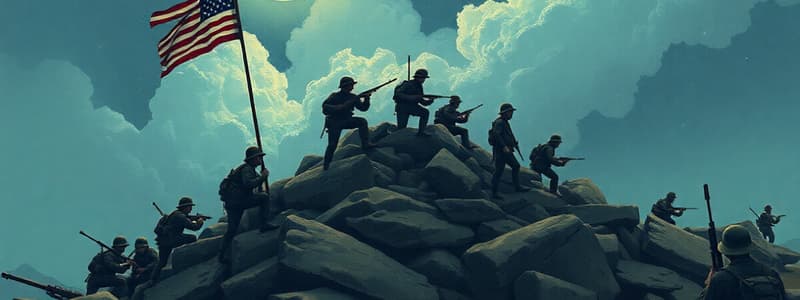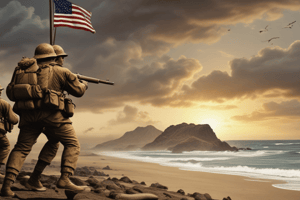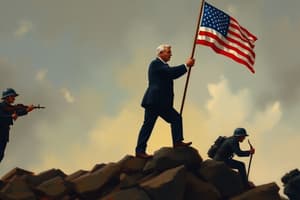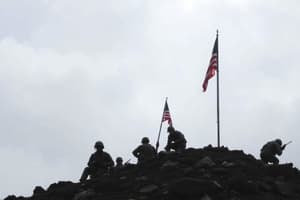Podcast
Questions and Answers
Explain the strategic considerations that led to the U.S. decision to invade Iwo Jima, focusing on its geographical importance in relation to Japan's inner defense zone and the broader Pacific theater.
Explain the strategic considerations that led to the U.S. decision to invade Iwo Jima, focusing on its geographical importance in relation to Japan's inner defense zone and the broader Pacific theater.
Iwo Jima, part of the Bonins-Volcano group, served as a stepping stone to the heart of Japan and was integral to Japan's inner defense zone. Its capture aimed to disrupt Japanese air defenses, provide a base for U.S. fighters, and offer emergency landing sites for B-29 bombers.
How did General Tadamichi Kuribayashi's defensive strategies on Iwo Jima differ from traditional Japanese tactics, and what impact did this have on the battle's progression and the casualties sustained by both sides?
How did General Tadamichi Kuribayashi's defensive strategies on Iwo Jima differ from traditional Japanese tactics, and what impact did this have on the battle's progression and the casualties sustained by both sides?
Kuribayashi abandoned banzai charges in favor of a strategy of attrition, utilizing heavily fortified positions and tunnel systems. This approach prolonged the battle, increased U.S. casualties, and forced the Americans into costly ground assaults.
Detail the logistical and environmental challenges faced by U.S. forces during the landing and initial assault on Iwo Jima, and explain how these factors influenced the battle's early stages.
Detail the logistical and environmental challenges faced by U.S. forces during the landing and initial assault on Iwo Jima, and explain how these factors influenced the battle's early stages.
The landing was hampered by unstable black sand beaches, steep terraces, volcanic ash, and a violent surf zone. These conditions slowed the buildup of forces and supplies, leaving troops vulnerable to intense Japanese fire and resulting in heavy casualties.
Although the capture of Mount Suribachi and the raising of the American flag are iconic symbols of the Battle of Iwo Jima, how did the continued Japanese resistance on the mountain affect the overall course and duration of the battle?
Although the capture of Mount Suribachi and the raising of the American flag are iconic symbols of the Battle of Iwo Jima, how did the continued Japanese resistance on the mountain affect the overall course and duration of the battle?
Assess the effectiveness of the pre-invasion bombardment of Iwo Jima by U.S. naval and air forces, considering the extent of the Japanese underground fortifications and their impact on the battle's outcome.
Assess the effectiveness of the pre-invasion bombardment of Iwo Jima by U.S. naval and air forces, considering the extent of the Japanese underground fortifications and their impact on the battle's outcome.
Critique the decision to proceed with Operation Detachment in the context of its ultimate strategic value, considering the high human cost and the limited operational impact of Iwo Jima's airfields in supporting the strategic bombing campaign against Japan.
Critique the decision to proceed with Operation Detachment in the context of its ultimate strategic value, considering the high human cost and the limited operational impact of Iwo Jima's airfields in supporting the strategic bombing campaign against Japan.
Describe the evolution of Japanese defensive doctrine from the Central Pacific battles of 1943-1944 to the Battle of Iwo Jima, emphasizing the key differences and the rationale behind these changes.
Describe the evolution of Japanese defensive doctrine from the Central Pacific battles of 1943-1944 to the Battle of Iwo Jima, emphasizing the key differences and the rationale behind these changes.
Analyze the role of the U.S. Fifth Fleet during Operation Detachment, focusing on the balance between providing amphibious lift, gunfire support, and air cover, and how these priorities influenced the battle's progression.
Analyze the role of the U.S. Fifth Fleet during Operation Detachment, focusing on the balance between providing amphibious lift, gunfire support, and air cover, and how these priorities influenced the battle's progression.
Compare and contrast the experiences of the 5th Marine Division and the 4th Marine Division during the initial landings on Iwo Jima, explaining how their respective objectives and the terrain they encountered influenced their progress and casualty rates.
Compare and contrast the experiences of the 5th Marine Division and the 4th Marine Division during the initial landings on Iwo Jima, explaining how their respective objectives and the terrain they encountered influenced their progress and casualty rates.
Assess the impact of the loss of the escort carrier Bismarck Sea and the severe damage to the fleet carrier Saratoga due to the only kamikaze attack experienced during the operation, on the overall U.S. naval operations during the battle.
Assess the impact of the loss of the escort carrier Bismarck Sea and the severe damage to the fleet carrier Saratoga due to the only kamikaze attack experienced during the operation, on the overall U.S. naval operations during the battle.
How did the unexpected volume and precision of Japanese artillery and mortar fire following the initial landings affect the morale and operational capabilities of the U.S. Marines, and what adjustments were made in response?
How did the unexpected volume and precision of Japanese artillery and mortar fire following the initial landings affect the morale and operational capabilities of the U.S. Marines, and what adjustments were made in response?
Explain how the landscape of Iwo Jima, including Mount Suribachi, the airfields, and the volcanic terrain, played an integral role in General Kuribayashi's defensive strategy, and how it influenced how invading forces approached the island.
Explain how the landscape of Iwo Jima, including Mount Suribachi, the airfields, and the volcanic terrain, played an integral role in General Kuribayashi's defensive strategy, and how it influenced how invading forces approached the island.
Detail the role and impact of small teams of Marines armed with flame throwers, satchel charges, and hand grenades in overcoming Japanese strongpoints on Iwo Jima.
Detail the role and impact of small teams of Marines armed with flame throwers, satchel charges, and hand grenades in overcoming Japanese strongpoints on Iwo Jima.
Analyze the broader implications of the Battle of Iwo Jima on the strategic and moral considerations of the Pacific Theater, considering the impact of the intense conflict on US military approaches and public opinion.
Analyze the broader implications of the Battle of Iwo Jima on the strategic and moral considerations of the Pacific Theater, considering the impact of the intense conflict on US military approaches and public opinion.
What specific intelligence failures or misinterpretations led to the U.S. military's underestimation of the strength and complexity of the Japanese defenses on Iwo Jima before the operation?
What specific intelligence failures or misinterpretations led to the U.S. military's underestimation of the strength and complexity of the Japanese defenses on Iwo Jima before the operation?
Explain the significance of the B-29 bomber "Dinah" making an emergency landing and departing, and its impact on the assessment of the island by the XXI Bomber Command.
Explain the significance of the B-29 bomber "Dinah" making an emergency landing and departing, and its impact on the assessment of the island by the XXI Bomber Command.
Contrast the immediate perception of Iwo Jima's strategic value after its capture with the actual benefits realized during the remainder of the war, particularly regarding its use as a base for fighter escorts and emergency landings.
Contrast the immediate perception of Iwo Jima's strategic value after its capture with the actual benefits realized during the remainder of the war, particularly regarding its use as a base for fighter escorts and emergency landings.
How did the Battle of Iwo Jima influence the development and deployment of specialized military equipment and tactics used by the U.S. Marine Corps in subsequent Pacific campaigns?
How did the Battle of Iwo Jima influence the development and deployment of specialized military equipment and tactics used by the U.S. Marine Corps in subsequent Pacific campaigns?
In what ways did the Battle of Iwo Jima serve as a microcosm of the larger strategic and ideological conflict between the United States and Japan during World War II?
In what ways did the Battle of Iwo Jima serve as a microcosm of the larger strategic and ideological conflict between the United States and Japan during World War II?
Having done his utmost to forestall the U.S. forces on Iwo Jima, what ultimate action did General Kuribayashi take, and what did it symbolize?
Having done his utmost to forestall the U.S. forces on Iwo Jima, what ultimate action did General Kuribayashi take, and what did it symbolize?
Flashcards
Operation Detachment
Operation Detachment
Amphibious assault on Iwo Jima, aimed at securing Luzon and other strategic locations.
Douglas MacArthur
Douglas MacArthur
Commander of the Southwest Pacific Area, who strongly advocated for securing Luzon.
Bonins-Volcano and Ryukus
Bonins-Volcano and Ryukus
Island chains, including Iwo Jima and Okinawa, serving as stepping stones towards Japan.
Raymond A. Spruance
Raymond A. Spruance
Signup and view all the flashcards
Holland M. Smith
Holland M. Smith
Signup and view all the flashcards
Tadamichi Kuribayashi
Tadamichi Kuribayashi
Signup and view all the flashcards
Mount Suribachi
Mount Suribachi
Signup and view all the flashcards
Iwo Jima Landing Beaches
Iwo Jima Landing Beaches
Signup and view all the flashcards
Blow Torches and Corkscrews
Blow Torches and Corkscrews
Signup and view all the flashcards
Iwo Jima's Airfields
Iwo Jima's Airfields
Signup and view all the flashcards
Chester W. Nimitz
Chester W. Nimitz
Signup and view all the flashcards
Study Notes
Battle of Iwo Jima
- Battle took place between February 19 and March 26, 1945.
Background
- Operation Detachment originated from a strategic planning conference in San Francisco from September 29 to October 1, 1944.
- Senior Pacific theater commanders and Joint Chiefs of Staff representatives attended the conference.
- Securing Luzon in the Philippines was the priority.
- General Douglas MacArthur advocated for securing Luzon.
- Although the target date for Luzon was December 20, the operation occurred on January 9, 1945.
- All strategic locations in Luzon were secured by March.
- After Luzon, the plan was to occupy the Bonins-Volcano group (including Iwo Jima) and the Ryukus (including Okinawa).
- The Bonins and Ryukus island chains run north to south in the Pacific, south of Japan's Honshu Island.
- The Bonins (Nanpo Shoto) and Ryukus (Nansei Shoto) were considered stepping stones to Japan and vital to Japan's inner defense.
Prelude
- The U.S. Army Air Forces gained prominence due to the strategic bombing campaign against Japan.
- A Japanese radar site on Iwo Jima provided early warning for U.S. air raids and served as a base for intercepting Japanese fighters.
- B-29s had to fly a longer route around Iwo Jima as a result.
- Securing Iwo Jima would provide airfields for fighter escorts and emergency landings for damaged B-29s.
- Post-Detachment, the assumption about Japanese early warning capabilities proved incorrect.
- Airfields' strategic utility was diminished by events elsewhere; the justification for the operation's high human cost is still debated.
- The U.S. Fifth Fleet (Admiral Raymond A. Spruance) was assigned to provide amphibious lift, gunfire support, air cover, and logistical support for Operation Detachment using Expeditionary Task Force TF-56, led by General Holland M. Smith, USMC.
- V Amphibious Corps (Major General Harry Schmidt, USMC) was primarily made up of the 3rd, 4th, and 5th Marine Divisions, the Army’s 147th Infantry Regiment, and support units.
- D-Day was set for February 19, 1945.
- Approximately 60,000 U.S. service members faced about 21,000 Japanese troops on Iwo Jima.
- Japanese defensive doctrine shifted after the Central Pacific battles of 1943 and early 1944.
- By June 1944, many senior Japanese officers considered Allied victory inevitable.
- Japanese commanders aimed to delay the Allies at the highest cost.
- The Japanese did not attempt to repulse Allied forces on landing beaches, as seen on Peleliu in September 1944.
- Assault troops faced a step-by-step battle of attrition, advancing through well-defended killing zones.
- U.S. air superiority led Japanese forces to construct mutually supporting, deeply sited, and heavily fortified strongpoints often connected by tunnels with ammunition and food stockpiles.
- Japanese response was to dig in and dig deep for defense.
- Assigned to Iwo Jima in June 1944, General Tadamichi Kuribayashi began extensive defensive preparations, working at night to avoid aerial attacks.
- Kuribayashi learned lessons from the fighting on Peleliu,.
- Kuribayashi discouraged banzai charges, prioritizing delaying and inflicting casualties on the enemy.
- Before the Fifth Fleet started bombarding Iwo Jima, all Japanese civilians had been evacuated.
- Kuribayashi aimed to make the U.S. assault as costly as possible, using Iwo Jima’s difficult terrain to aid the Japanese defense.
The Battle
- Iwo Jima is eight square miles, shaped like a pork chop with its widest part toward the northeast.
- Mount Suribachi, a dormant volcano, dominates the island’s narrow southwestern tip.
- Iwo Jima had two completed airfields and one under construction from the southwest to the northeast along its centerline.
- Kuribayashi divided the island into five defensive sectors with central reserve areas.
- U.S. planners designated landing beaches on the southern and northern shorelines between Suribachi and the island's wider part.
- Only the southern beaches (Green, Red, Yellow, Blue) were used for the assault.
- Bombing raids and naval bombardment occurred against Japanese facilities on Iwo Jima beginning in June 1944, intensifying before D-day.
- Air raids damaged fortifications, but Navy underwater demolition teams underestimated the extent of Japanese underground fortifications.
- V Amphibious Corps requested a concentrated shore bombardment for 10 days before landings.
- Due to ammunition supply issues, Task Force 52 provided only three days of fire support.
- Adverse weather restricted bombardment on February 16, the first day, and only 13 hours of effective bombardment occurred.
- Fifth Fleet conducted minesweeping around the island, focusing on approaches to landing beaches.
- Spruance detached Task Force 58 to strike strategic targets on Honshu to support the Iwo Jima landings.
- Marines were unhappy of the shortened naval gunfire support, prioritizing continuous close air support for ground forces.
- At H-hour (0900 on February 19), the first assault wave landed on assigned beach sectors, with the 5th Marine Division on the left and the 4th Marine Division on the right.
- The Japanese held fire until 1000, after the Marines' first wave landed.
- Volume and accuracy of artillery and mortars indicated bombing and naval bombardment was not greatly effective.
- Casualties occurred in all sectors, with Green, Red, and Blue beaches being the hardest hit.
- The beaches were unstable due to steep terraces of shifting black sand, volcanic cinders, and ash, which made digging difficult and bogged down vehicles.
- Men, amphibious tractors, tanks, and supplies piled up at the waterline.
- They were subjected to Japanese artillery, mortar, and machine-gun fire.
- The steep beach gradient caused a violent surf zone.
- The landings were completed successfully under a rolling naval gunfire barrage and close air support from Fifth Fleet’s escort carriers
- The Marines began moving off the beaches.
- The 5th Marine Division pushed to the northwestern shore to isolate Mount Suribachi in ninety minutes.
- The 4th Marine Division advanced more slowly toward airfields, with one directly in front of the Marines.
- The second airfield required a wheeling movement to the northeast, exposing the division to heavy Japanese fire.
- By the end of D-day, about 30,000 personnel had been landed on Iwo Jima.
- Weather conditions deteriorated quickly & well-coordinated Japanese resistance put pressure on marines.
- The Marines crossed the island at its narrow width, cutting off Mount Suribachi, but the planned phase line was not reached and casualties were high.
- The beachhead was concentrated in a triangular area roughly 4,000 yards long and 700 to 1,100 yards wide.
- D+1 saw the landing of the 3rd Marine Division, the corps reserve, which then occupied battle space between the two previously committed Marine divisions.
- The 5th Division’s 28th Marine Regiment began its assault of Mount Suribachi.
- Mount Suribachi was garrisoned by 2,000 Japanese troops, possessing defensive positions and tunnels, one of which was seven levels deep.
- Bolstered by reinforcements from 3rd Marine Division, other 5th Marine Division units, and the 4th Marine Division, U.S. forces advanced northwest and northeast.
- Navy destroyers, assigned to Marine units, provided direct gunfire support.
- Marine tanks, amphtracs, and artillery provided mobile firepower, although were targeted by Japanese guns
- Fifth Fleet aircraft provided close air support, dropping napalm.
- Small teams of Marines, sometimes individuals, with flame throwers, satchel charges, and hand grenades (“blow torches and corkscrews”) destroyed Japanese strongpoints.
- Companies lost up to 50% of their pre-assault strength, with only yards of ground gained.
- The amphibious landing area were subjected to a kamikaze attack during the night of February 21–22, resulting in high casualties.
- The escort carrier Bismarck Sea (CVE-95) was lost and fleet carrier Saratoga (CV-3) was badly damaged.
- Marines reached the summit of Mount Suribachi on February 23 after the initial landing.
- Hidden pockets of enemy still resisted on the mountain.
- Airfield No. 1 was captured after fighting, and the armored task force helped marines move north.
- The Japanese launched coordinated counterattacks, as opposed to the banzai charges marines were used to.
- Tanks were disabled by mines, suicide squads, or antitan guns.
- Marine rifle companies were targeted by artillery, mortar, and small-arms fire.
- Japanese positions proved impervious to close air support bombing and required direct ground assault or sealing off entrances.
- After nine days, the drive north had progressed 4,000 yards at a cost of 7,000 U.S. casualties.
- By March 4, Airfield No. 2 had been secured & General Kuribyashi’s defenses were degraded to the point at which many Japanese heavy weapons were out of action.
- On March 4, the 9th Bomb Group's B-29 “Dinah” made an emergency landing on Airfield No. 1, refueled, and departed.
- On March 14, the island’s occupation was officially announced, although fighting continued for two further weeks.
- On March 26, Iwo Jima was declared “secure.”
Aftermath
- Of the 21,000 Japanese defenders, 216 were taken prisoner & approximately 3,000 went into hiding after U.S. occupation of the island.
- By August 1945, one group did not surrender.
- General Kuribayashi committed suicide in his command post on March 23, 1945
- American operators determined the Japanese radar station could not provide early warning data to Japanese Home Island air defenses.
- Before Operation Detachment, the Japanese had written off the island’s airfield.
- Iwo Jima’s airfields presented a challenge.
- Utilizing Iwo Jima’s airfields for U.S. escort fighters proved logistically difficult.
- The P-51 pilots faced a 1,500 nautical mile round trip.
- The fields were limited, with the capacity of one Navy fleet carrier and few B-29.
- The airfields hosted search-and-rescue operations & aircraft picked up downed U.S. aviators
- Operation Detachment cost U.S. forces 6,871 killed and 19,217 wounded.
- 22 Marines and five Sailors received Medals of Honor, with 14 posthumously
- Admiral Chester W. Nimitz noted, “uncommon valor was a common virtue.”
Studying That Suits You
Use AI to generate personalized quizzes and flashcards to suit your learning preferences.




